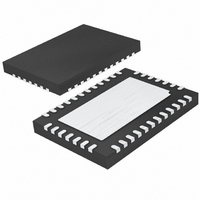LTC3586EUFE-1#TRPBF Linear Technology, LTC3586EUFE-1#TRPBF Datasheet - Page 22

LTC3586EUFE-1#TRPBF
Manufacturer Part Number
LTC3586EUFE-1#TRPBF
Description
IC POWER MANAGER USB 38-QFN
Manufacturer
Linear Technology
Datasheet
1.LTC3586EUFEPBF.pdf
(36 pages)
Specifications of LTC3586EUFE-1#TRPBF
Applications
Handheld/Mobile Devices
Voltage - Supply
4.35 V ~ 5.5 V
Operating Temperature
-40°C ~ 85°C
Mounting Type
Surface Mount
Package / Case
38-QFN
Lead Free Status / RoHS Status
Lead free / RoHS Compliant
Current - Supply
-
Available stocks
Company
Part Number
Manufacturer
Quantity
Price
operaTion
LTC3586/LTC3586-1
Buck Regulator Dropout Operation
It is possible for a buck regulator’s input voltage, V
approach its programmed output voltage (e.g., a battery
voltage of 3.4V with a programmed output voltage of 3.3V).
When this happens, the PMOS switch duty cycle increases
until it is turned on continuously at 100%. In this dropout
condition, the respective output voltage equals the buck
regulator’s input voltage minus the voltage drops across
the internal P-channel MOSFET and the inductor.
Buck Regulator Soft-Start Operation
Soft-start is accomplished by gradually increasing the
peak inductor current for each buck regulator over a 500µs
period. This allows each output to rise slowly, helping
minimize the battery in-rush current. A soft-start cycle
occurs whenever a given buck regulator is enabled, or
after a fault condition has occurred (thermal shutdown
or UVLO). A soft-start cycle is not triggered by changing
operating modes. This allows seamless output operation
when transitioning between modes.
Buck Regulator Switching Slew Rate Control
The buck regulators contain new patent pending circuitry
to limit the slew rate of the switch node (SW1 and SW2).
This new circuitry is designed to transition the switch node
over a period of a couple of nanoseconds, significantly
reducing radiated EMI and conducted supply noise.
BUCK-BOOST DC/DC SWITCHING REGULATOR
The LTC3586/LTC3586-1 contain a 2.25MHz constant-
frequency voltage-mode buck-boost switching regulator.
The regulator provides up to 1A of output load current.
The buck-boost can be programmed to a minimum output
voltage of 2.5V and can be used to power a microcon-
troller core, microcontroller I/O, memory, disk drive, or
other logic circuitry. The converter is enabled by pulling
EN3 high. To suit a variety of applications, a selectable
mode function allows the user to trade-off noise for ef-
ficiency. Two modes are available to control the operation
of the LTC3586/LTC3586-1’s buck-boost regulator. At
moderate to heavy loads, the constant frequency PWM
mode provides the least noise switching solution. At
lighter loads Burst Mode operation may be selected. The
INx
, to
output voltage is programmed by a user-supplied resistive
divider returned to FB3. An error amplifier compares the
divided output voltage with a reference and adjusts the
compensation voltage accordingly until the FB3 pin has
stabilized to the reference voltage (0.8V). The buck-boost
regulator includes a soft-start to limit inrush current and
voltage overshoot when powering on, short-circuit cur-
rent protection, and switch node slew limiting circuitry
for reduced radiated EMI.
Input Current Limit
The input current limit comparator will shut the input
PMOS switch off once current exceeds 2.5A (typical). The
2.5A input current limit also protects against a grounded
V
Output Overvoltage Protection
If the FB3 node were inadvertently shorted to ground, then
the output would increase indefinitely with the maximum
current that could be sourced from V
LTC3586-1 protect against this by shutting off the input
PMOS if the output voltage exceeds 5.6V (typical).
Low Output Voltage Operation
When the output voltage is below 2.65V (typical) during
start-up, Burst Mode operation is disabled and switch D
is turned off (allowing forward current through the well
diode and limiting reverse current to 0mA).
Buck-Boost Regulator PWM Operating Mode
In PWM mode the voltage seen at FB3 is compared to the
reference voltage (0.8V). From the FB3 voltage an error
amplifier generates an error signal seen at V
signal commands PWM waveforms that modulate switches
A, B, C, and D. Switches A and B operate synchronously
as do switches C and D. If V
than the programmed V
erate in buck mode. In this case switches A and B will be
modulated, with switch D always on (and switch C always
off), to step-down the input voltage to the programmed
output. If V
V
this case switches C and D are modulated, with switch A
OUT3
OUT3
, then the converter will operate in boost mode. In
node.
IN3
is significantly less than the programmed
OUT3
, then the converter will op-
IN3
is significantly greater
IN3
. The LTC3586/
C3
. This error
3586fb















